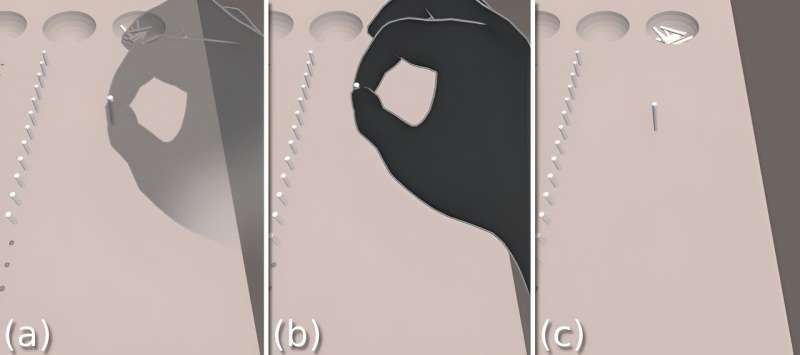This article has been reviewed according to Science X's editorial process and policies. Editors have highlighted the following attributes while ensuring the content's credibility:
fact-checked
trusted source
proofread
A virtual reality pegboard test shows performance does not always match user preference

Virtual hand interactions are one of the most common and useful applications that virtual reality (VR) systems offer users. But, as a new Concordia-led study shows, personal preference remains an important factor in how the technology is applied, regardless of the effect on overall performance.
In a paper presented at the IEEE International Symposium on Mixed and Augmented Reality (ISMAR) in October 20203, the researchers shared their findings from experiments involving participants performing repetitive tasks on a VR-based Purdue Pegboard Test (PPT).
One of the many applications of PPT is as a therapeutic tool for patients who have suffered neurological damage, such as a stroke. It is designed to improve gross and fine motor skills.
The participants were equipped with a VR headset. They were then instructed to pick up a virtual object and place it in a hole as quickly and as accurately as possible. Variations involved using dominant and non-dominant hands, both hands and assembly tasks.
The tasks were repeated across three separate modes. In the first instance, the user's virtual hand was opaque, meaning they could not through see through it. In the second instance, the outline of the user's hand was visible but the hand itself was transparent. And in the third case, the hand disappeared once the peg was picked up.
Metrics such as duration, downtime, movement time, path length, linear velocity, angle and angular velocity were recorded.
The opaque hands were found to have performed noticeably slower. Users opened their fingers more narrowly and performed fewer tasks when compared to invisible hand visualization.
"This is what we hypothesized, because the invisible hand visualization does not occlude the object the participant is holding," says lead author Laurent Voisard. "The invisible hand gives users more control and lets them see where they are placing their peg better. It also increases motor dexterity when performing movements requiring fine hand movements. This case could be used to create more effective and efficient medical applications in VR.
"But the participants did not all necessarily prefer the invisible hand," he adds. "In fact, 10 participants said they preferred the transparent hand while seven chose the opaque hand. Seven others selected the invisible hand."

Participants who preferred the transparent hand emphasized that they felt the hands and the environment were easier to perceive at the same time. They also said it was easy to interact with the objects.
Participants who preferred the opaque hand said movements were easier to track and control. Conversely, participants who liked the invisible hand said they found it easier and more comfortable to accomplish the task and to understand when it was completed.
Personalizing home rehab
The researchers say they hope the study can serve as a basis for more research. Potential topics include how VR and PPT can be used therapeutically, and how they can be applied in technical fields such as surgery planning.
"Every individual is different, so they will have different preferences. That is why we recommend giving users the choice of how they visualize their VR experience," says co-author Anil Ufuk Batmaz, an assistant professor the Department of Computer Science and Software Engineering at the Gina Cody School of Engineering and Computer Science. Batmaz is also the director of the EXIT Lab.
"One visualization may have better results. But if it is not preferred by users, then they may not use the system at all."
"The PPT is often used as a diagnostic tool by neurologists for people who have suffered brain injuries or strokes. However, it can also be used for rehabilitation," notes co-author Marta Kersten-Oertel, an associate professor in the same department and the director of the Applied Perception Lab.
"Studies like ours show the best interaction methods for doing this type of rehabilitation at home in a virtual environment."
Amal Hatira and Mine Sarac at Kadir Has University in Istanbul, Turkey, also contributed to this study.
More information: Laurent Voisard et al, Effects of Opaque, Transparent and Invisible Hand Visualization Styles on Motor Dexterity in a Virtual Reality Based Purdue Pegboard Test, 2023 IEEE International Symposium on Mixed and Augmented Reality (ISMAR) (2023). DOI: 10.1109/ISMAR59233.2023.00087





















